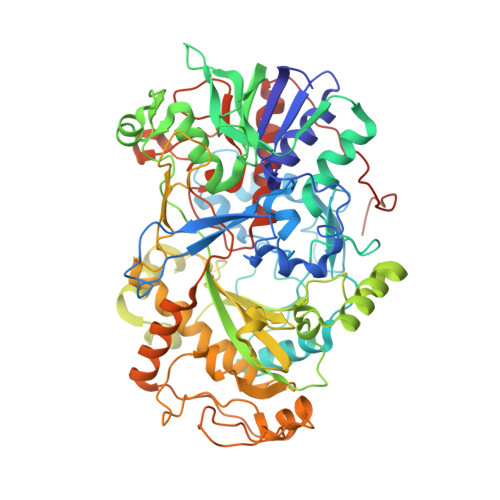Structure-Based Engineering of Phanerochaete chrysosporium Alcohol Oxidase for Enhanced Oxidative Power toward Glycerol.
Nguyen, Q.T., Romero, E., Dijkman, W.P., de Vasconcellos, S.P., Binda, C., Mattevi, A., Fraaije, M.W.(2018) Biochemistry 57: 6209-6218
- PubMed: 30272958
- DOI: https://doi.org/10.1021/acs.biochem.8b00918
- Primary Citation of Related Structures:
6H3G, 6H3O - PubMed Abstract:
Glycerol is a major byproduct of biodiesel production, and enzymes that oxidize this compound have been long sought after. The recently described alcohol oxidase from the white-rot basidiomycete Phanerochaete chrysosporium (PcAOX) was reported to feature very mild activity on glycerol. Here, we describe the comprehensive structural and biochemical characterization of this enzyme. PcAOX was expressed in Escherichia coli in high yields and displayed high thermostability. Steady-state kinetics revealed that PcAOX is highly active toward methanol, ethanol, and 1-propanol ( k cat = 18, 19, and 11 s -1 , respectively), but showed very limited activity toward glycerol ( k obs = 0.2 s -1 at 2 M substrate). The crystal structure of the homo-octameric PcAOX was determined at a resolution of 2.6 Å. The catalytic center is a remarkable solvent-inaccessible cavity located at the re side of the flavin cofactor. Its small size explains the observed preference for methanol and ethanol as best substrates. These findings led us to design several cavity-enlarging mutants with significantly improved activity toward glycerol. Among them, the F101S variant had a high k cat value of 3 s -1 , retaining a high degree of thermostability. The crystal structure of F101S PcAOX was solved, confirming the site of mutation and the larger substrate-binding pocket. Our data demonstrate that PcAOX is a very promising enzyme for glycerol biotransformation.
- Molecular Enzymology Group, Groningen Biomolecular Sciences and Biotechnology Institute , University of Groningen , Nijenborgh 4 , 9747 AG Groningen , The Netherlands.
Organizational Affiliation:


















